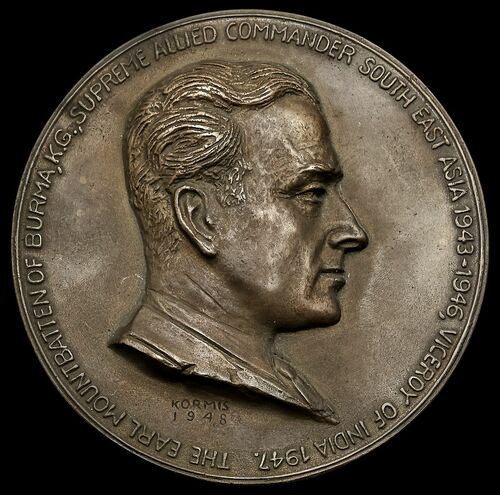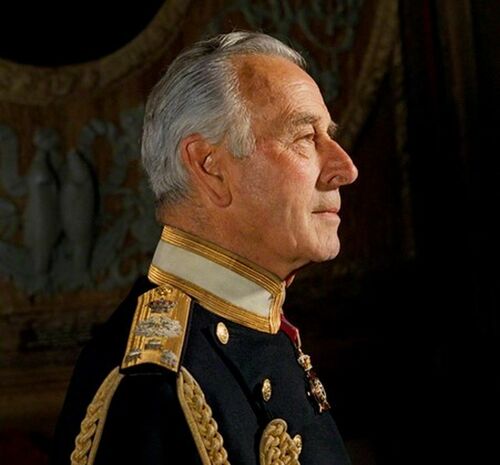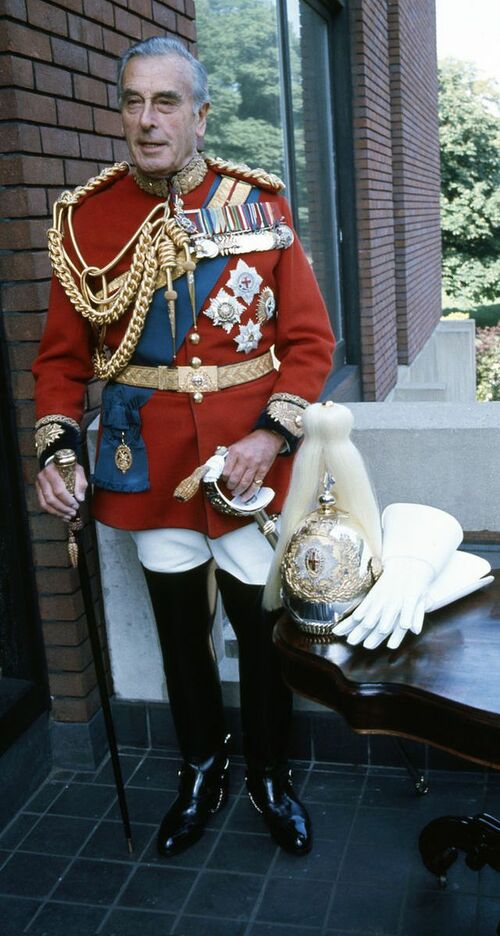Auction: 23003 - Orders, Decorations and Medals
Lot: 135
The extremely rare Earl Mountbatten of Burma Medal
The Earl Mountbatten of Burma Medal, cast uniface Medal by Kormis, 1948, 136mm, the obverse with his portrait surrounded with the inscription 'The Earl Mountbatten of Burma, K.G., Supreme Allied Commander South East Asia 1943-1946, Viceroy of India 1947.', the reverse blank and with fittings from previous mounting, good very fine and of the highest rarity (Puddester India 947.2 BCM 398.2 E 2075 BHM 4418)
Provenance:
The Estate of his daughter, 2nd Countess Mountbatten of Burma, Lady Brabourne.
Puddester in British India Historical Medals gives more detail:
'This large cast Medal was actually issued in 1948, an issue of seven Medals, four of which were purchased by Earl Mountbatten. An eight Medal was cast for Prince Philip after the assassination of Mountbatten. Of the major Museums the British Museum appears to have the only example. The only specimen traced in a public sale was in Glendining's of June 1990.'
Another example has been traced in the Royal Collection Trust (RCIN 443788). Details of the artist Frederick Kormis is provided from biographies for Kormis at the British Museum and National Portrait Gallery and his Times obituary:
'Fritz Kormis (1887-1986) was born and raised in Frankfurt-am-Main of Jewish parentage. According to Bridget Clarke (see below) he was apprenticed in a sculptor's workshop before 1914. During the First World War Kormis served in the Austro-Hungarian army and was held in a Siberian war camp from 1915-20. Here he managed to make a number of woodcuts and prints, some examples of which are in the British Museum.
From 1920 he set up a sculpture studio in his native Frankfurt but was forbidden to practice when Hitler came to power. Foreseeing the difficulties ahead, Kormis fled to Holland in 1933 where he held exhibitions in Amsterdam and the Hague. He then moved on to England where he remained and anglicized his name Fritz to Fred. In 1940 Kormis's studio was bombed and much of his work was lost. However he continued to work energetically despite this major setback.
Kormis was especially known for his portrait heads and medals. His sitters included Charlie Chaplin, Winston Churchill, H.M. King Hakkon of Norway, Prince Edward, Duke of Windsor (King Edward VIII), Earl Mountbatten of Burma, the Duke of Edinburgh, Alexander Fleming, and Henry Moore. During the Second World War he completed two series of medals depicting members of the war cabinet and heads of allied governments. There are examples of his medals in the National Portrait Gallery, British Museum and Royal Collection.
Kormis's other major works include 'The Marchers' at Nuffield College, Oxford; Kings' College, London and University College Swansea; the sarcophagus and effigy of Lady Methuen carved in rose alabaster for Corsham Church; and the Prisoner of War Memorial in Gladstone Park, Dollis Hill Lane, Willsden (1970) and 'The Prophetess', Swansea Leisure Centre (1972). Kormis entered the competition for the British Holocaust Memorial and later gave a model of his unsuccessful design to Yad Vashem in Jerusalem. His work was the subject of one-person exhibitions at the Beaux Arts Gallery in 1956 and the Fieldborne Galleries in 1982. Kormis was still working in 1977, the year he created his last medallion - a portrait of the art historian, Lord Kenneth Clarke.'
Subject to 20% VAT on Buyer’s Premium. For more information please view Terms and Conditions for Buyers.
Sold for
£1,300
Starting price
£1200









